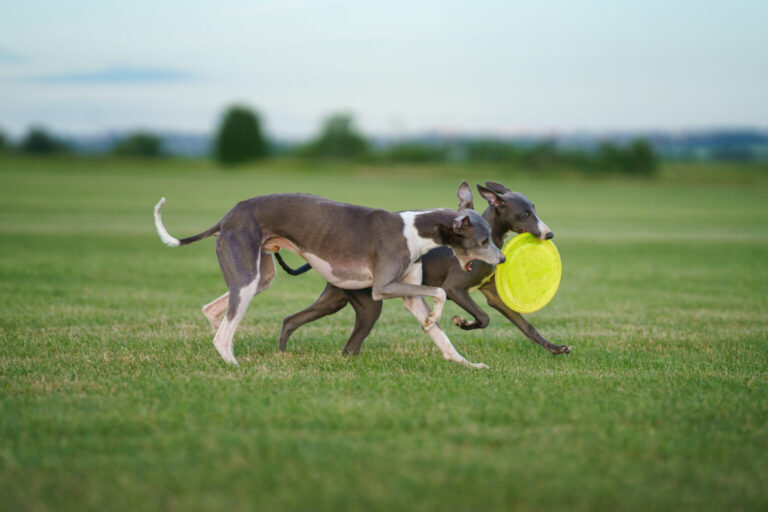Greyhound Dog Breed

| Aspect | Details |
|---|---|
| Origin | Egypt |
| Birth Era | Ancient times |
| Crossbreed | No, purebred |
| Temperament | Gentle, independent, intelligent, quiet |
| Physique | Medium to large, 60-70 pounds, slim |
| Coat | Short, smooth, fine coat |
| Lifespan | 10-14 years |
The Greyhound breed is renowned worldwide for its speed and grace, but in Japan, its unique beauty is particularly esteemed. With origins dating back to ancient Egypt, this breed’s slim, muscular build resonates with traditional Japanese aesthetics. Especially notable are its long legs and streamlined body, evoking the fluid and delicate movements found in Japanese traditional performing arts and sports. In Japan, there is a preference for calm and gentle interaction with animals, making the Greyhound’s loyal and serene nature highly suitable for a family pet.

However, given their lively disposition and need for substantial exercise, ensuring adequate physical activity and a gentle approach is crucial. This mirrors the Japanese ethos of striving for a balanced coexistence with pets.
Coat Color

The Greyhound dog’s coat is a vibrant tapestry of colors, ranging from the deepest blacks to the most delicate fawns, the purest whites, and the rarest blues. These colors can be solid or mixed, often featuring unique brindle patterns that create a striking, almost painted appearance.

The variety in their coat color is a true reflection of the breed’s diverse genetic heritage and contributes significantly to their individuality and aesthetic appeal.
Coat Type

Their coat is short, fine, and smooth to the touch, offering a practical advantage for both speed and ease of maintenance. This coat type reflects their historical role as swift hunters and racers, minimizing air resistance and providing a sleek silhouette.

For pet owners, this translates to minimal shedding and grooming requirements, making them an ideal choice for individuals who appreciate cleanliness and low maintenance.
Size

Greyhound dogs are statuesque, with males typically reaching heights of 28 to 30 inches at the shoulder and females being slightly shorter. This height, paired with their slender, aerodynamic build, is a physical trait developed for high-speed pursuits.

Despite their size, they are surprisingly graceful and agile, capable of navigating both open fields and cozy home environments with ease.
Weight

Weighing between 60 to 70 pounds, Greyhound dogs maintain a physique that is both athletic and elegant.

Their weight is a crucial factor in their overall health and performance, emphasizing the importance of a balanced diet and regular exercise to keep them in peak condition.
Lifespan

The Greyhound dog enjoys a lifespan of approximately 10 to 14 years, a testament to the breed’s robust genetic makeup when cared for properly. Factors such as quality nutrition, regular physical activity, and consistent veterinary care play a significant role in extending their lifespan and enhancing their quality of life.

The relatively long lifespan of Greyhounds resonates with the Japanese value of longevity and respect for the elderly, symbolizing endurance and perseverance
Trainability

Greyhound dogs are known for their intelligence and eagerness to learn. They respond positively to training methods that involve kindness and positive reinforcement.

Their quick learning ability, coupled with an independent spirit, makes training a rewarding experience that strengthens the bond between the dog and its owner.
Exercise

Despite their fame as racing dogs, Greyhound dogs’ exercise needs are surprisingly manageable. They enjoy short bursts of high-speed running but are equally content with leisurely walks and peaceful rest periods.

This adaptable nature makes them suitable for a variety of living situations, from active families to more sedentary lifestyles.
Feeding

A nutritious diet tailored to their specific needs is essential for maintaining the Greyhound dog’s health and vitality. Their lean body mass and high metabolism necessitate a diet rich in quality proteins and balanced nutrients. Portion control and regular feeding schedules are important to prevent overfeeding and maintain optimal body weight.
 In Japan, the concept of balanced nutrition and portion control, vital for the Greyhound’s diet, is parallel to the traditional Japanese diet, emphasizing variety and moderation.
In Japan, the concept of balanced nutrition and portion control, vital for the Greyhound’s diet, is parallel to the traditional Japanese diet, emphasizing variety and moderation.
Temperament

Greyhound dogs are renowned for their serene and affectionate temperament. They are gentle, patient, and often form deep bonds with their families. This breed is known for its quiet nature, making them an excellent choice for households seeking a peaceful, loving companion.

The calm and gentle temperament of Greyhounds is akin to the Japanese cultural emphasis on harmony and tranquility in both personal and social interactions.
History

The Greyhound dog has a rich and storied history, dating back thousands of years. Originally bred for hunting due to their keen sight and incredible speed, they have since transitioned to a role in competitive racing and, more recently, as cherished family pets. Their history is a blend of athleticism, nobility, and adaptability.

While Greyhounds have a distinct history in the West, their story can be appreciated in Japan through a cultural love for narrative and historical continuity.
Grooming


Grooming a Greyhound dog is a straightforward task, thanks to their short and low-shedding coat. Regular brushing, occasional baths, and basic hygiene practices like nail trimming and ear cleaning are sufficient to keep them looking and feeling their best.
Health

Greyhound dogs are generally a healthy breed, but they can be predisposed to certain health conditions such as hip dysplasia, heart issues, and bloat.

Regular health check-ups, a well-balanced diet, and adequate exercise are essential in maintaining their health and preventing common health issues.

